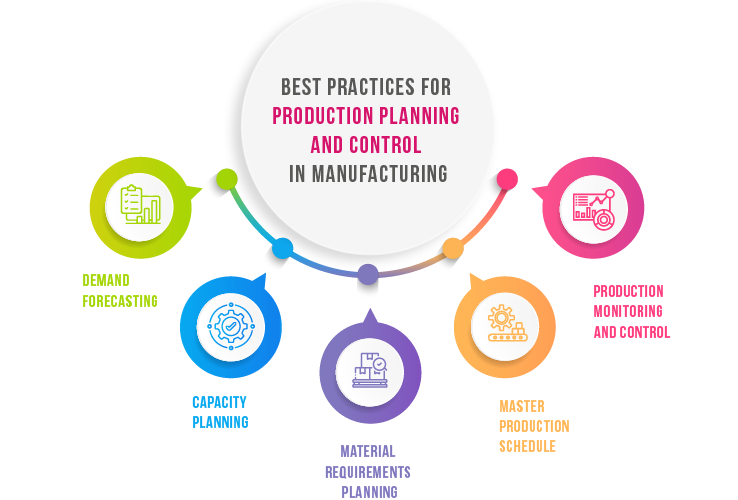Production Planning and Control (PPC) in manufacturing allows a company to manage resources, manpower, work centers, and machines and meet production goals efficiently. Manufacturers need to ensure the right resources are available at the right time and right place to meet customer demands. An efficient production planning and controlling process includes material requirements planning, master production schedules, forecasting, and more.
This blog post explores the best practices for efficient production planning and control in manufacturing.
What is Production Planning?
Production planning provides a plan to carry out manufacturing operations effectively. It helps manufacturers determine what resources are needed, when, and where to complete the production efficiently. The production manager is responsible for preparing and planning production activities working closely with the shop floor and other departments.
What is Production Control?
Production control monitors and evaluates operations to ensure everything is on track per the production plan. Production control includes using techniques to measure and track the production progress. It also includes taking corrective actions if needed to ensure continuous improvement.
What are the Best Practices for Production Planning and Control in Manufacturing?
Below are the best practices to implement efficient production planning and control in manufacturing.

1. Demand Forecasting
Manufacturers must be able to forecast demand and estimate the materials they need for production to meet on-time deliveries. Companies can forecast demand based on past sales data, supply and demand details from customers and sales, market trends and analysis, and external factors. Manufacturers should regularly monitor changes in market demands so needed changes are made to the production plan.
Manufacturing companies should compare the forecasted demand with the actual demand to make needed adjustmemts. Close collaboration across departments such as sales and marketing will help gain insights into market and customer demand.
2. Capacity Planning
Capacity planning is essential for manufacturing companies to ensure that machines, equipment, and labor are available to achieve maximum output. It involves assessing production capabilities and ensuring the required resources are in proper condition to optimize capacity for production. Production capacity should be aligned with the demand to ensure optimum resource utilization and avoid over-utilization or under-utilization.
Manufacturers must assess and evaluate the availability of the resources to ensure production completion within a stipulated time.
3. Material Requirements Planning (MRP)
Manufacturers require material requirements planning (MRP) for efficient production planning, scheduling, and inventory control. MRP is software that enables manufacturers to plan and manage inventory levels required to complete production. MRP system helps manufacturers determine what materials are needed to produce and how much material is based on the demand forecast. It ensures the availability of the right materials at the right place and at the right time to meet production goals and customer demand.
Manufacturers must plan their purchasing activities by analyzing the demand and generating orders needed for production. With MRP, manufacturing companies can minimize costs and optimize inventory levels by avoiding material shortages and overstocking.
4. Master Production Schedule (MPS)
The master production schedule (MPS) system translates the demand and customer orders into planned production activities. It schedules a sequence of production activities to complete a production and meet on-time deliveries. MPS ensures the production of the right materials at the right place and at the right time to meet customer demand with efficient utilization of resource constraints. The master production schedule calculates the production start and completion timeline, considering the various lead times.
Manufacturers must identify bottlenecks by monitoring the production schedules and comparing the planned schedules with actual production. It is suggested to maintain safety margin stock to meet fluctuating demand and other uncertainities to avoid production delays.
5. Production Monitoring and Control
Production monitoring and control involve measuring the production activities. It ensures that resource constraints are optimally utilized for production. Efficient production planning must include production monitoring and control to meet production targets within time frames and deliver high-quality products. Production monitoring and control help manufacturing companies minimize costs and maximize overall production efficiency.
Manufacturing companies must integrate automation tools for real-time monitoring of processes, machine performance, and quality control processes. It helps to gain real-time visibility into performance metrics and identify deviations. In case of any deviations, they can take corrective actions and drive continuous improvement.
Why Production Planning and Control?
Efficient production planning and control have significant importance in the manufacturing industry and have several benefits:
- Minimize costs by proper inventory handling and storage, avoid overstocking, and reduce material wastage and inventory handling costs.
- Minimize lead times, resulting in an optimized production process.
- Optimal utilization of resources leads to higher profitability, productivity, and increased overall operational efficiency.
- Enhanced customer satisfaction, ensuring the delivery of high-quality products.
- Facilitate informed decision-making with a well-structured plan, ensuring timely production.
Benefits of ERP in Production Planning and Control
Many manufacturing companies rely on planning tools such as spreadsheets and gant charts, which lack automation and cause manual errors. Maintaining and tracking complex production plans with spreadsheets and visualized charts can be a time consuming task.
ERP software helps manufacturers automate the process of effective production planning. It is a single solution for manufacturers operating all their manufacturing operations. According to Statista, the ERP market worldwide is projected to grow by 4.26% from 2024 to 2029. An ERP system such as Acumatica with in-built production planning tools can help manufacturers overcome challenges and manage complex production planning efficiently.
Integrate a Production Planning and Control Software To Optimize The Production
Production planning software enables manufacturers to connect systems, machines, and resources, resulting in an optimized production process. Implement the Acumatica ERP system and integrate Acumatica’s quality management and process manufacturing solutions to drive overall production efficiency and ensure that the product meets quality standards.
Contact us to learn more about Acumatica’s quality management and process manufacturing solutions.
Contact Us
"*" indicates required fields













